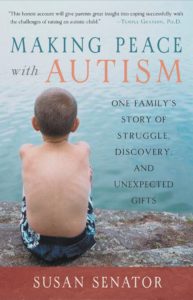Luke Jackson, the thirteen-year-old author of this book, says he wrote it because “so many books are written about us, but none are written directly to adolescents with Asperger Syndrome. I thought I would write one in the hope that we could all learn together.” And he does an amazing job of appealing to his peers in a colloquial manner.
I bought this book because I thought that Nigel, as a mid- to high-functioning autistic teen, would understand it and benefit from it. We read it together, so that we could discuss it as we went along. Jackson is English, so I occasionally had to “translate” a few words and phrases for Nigel, such as “fancy” for liking something. As we read, many times Nigel’s attention wandered, I think because he found Jackson’s writing style a little hard to follow. But then, Nigel does not have Asperger’s. I have often read that many people view Asperger’s as high-functioning autism, but there are many differences, which I will discuss in a future post.
Back to the well-written and enlightening book. Jackson’s style is almost precocious at times, but effective. He begins by introducing his close-knit family of seven children and their mother. (There is no mention of his father, that I recall, and I felt dizzy at the thought of parenting seven children alone.) It was interesting to read about their background and personalities. Jackson moves on to a description of Asperger’s and discusses the pros and cons of telling others about it. He relates that when people don’t know he has AS, they refer to him as a freak, but when they know about it, they are tolerant.
Next is a discussion of obsessions, which he calls “specialist subjects,” and compulsions. (Nigel was only vaguely interested in this section, which tells me that he does not think of himself as having obsessions.) For the compulsions, Jackson speaks to any parent readers by suggesting that they try to control their child’s compulsions with rewards.
The following three chapters concern sensory perception, physiology, and sleep, and Nigel managed to extract some helpful tips for himself. In the area of sensory perception, he agreed that looking at someone while they are talking is often difficult, and he liked Jackson’s suggestion to look at people’s mouths when they’re talking, which is close enough to making eye contact. Of the many suggestions that Jackson made in the sleep chapter, Nigel liked the following metaphor: “My room and my things are familiar, my security. The dark creeps in and steals that familiarity and security away.” Nigel also agreed that listening to relaxing CDs and music, something that Jackson mentioned, helps him to sleep. The section on physiology discussed, among other things, the GF/CF diet, which was not helpful to us, but certainly has been for others.
Next Jackson writes about language difficulties, dealing with slang and idioms, and suggests to parents that they write out steps to complete a task (which I also find immensely helpful) and give clear and specific instructions. The next chapters deal with school problems and bullying. In the school problems chapter, Nigel identified with the fact that writing with a utensil actually hurts his hand, and this was the first time that the problem registered in my mind. The bullying chapter had some tips for dealing with bullies and stressed that it was important to tell someone. Jackson then mentions Taekwondo for self-defense, as well as the many other benefits it provides.
The next three chapters dealt with friendships, dating, and morals and principles. Nigel is just getting interested in the topic of dating and has been asking questions, so this book helped a lot in that area. The “morals and principles” chapter also was beneficial in that it stressed not to let people entice you to do something that is wrong, that you don’t need friends like that. It reinforced what I tried to teach Nigel at the end of the last school year.
The end of the book has a nice positive note about AS people being amazing in their own ways, even if not savants (after a discussion about the movie Rainman). It is certainly amazing for a thirteen-year-old to write such an organized, insightful book. We found it very helpful, including the appendices on idioms (with definitions of being “on cloud nine” and “don’t cry over spilled milk”) and references for further information (books, websites, and organizations). All in all, a worthwhile book for parents and kids alike.



